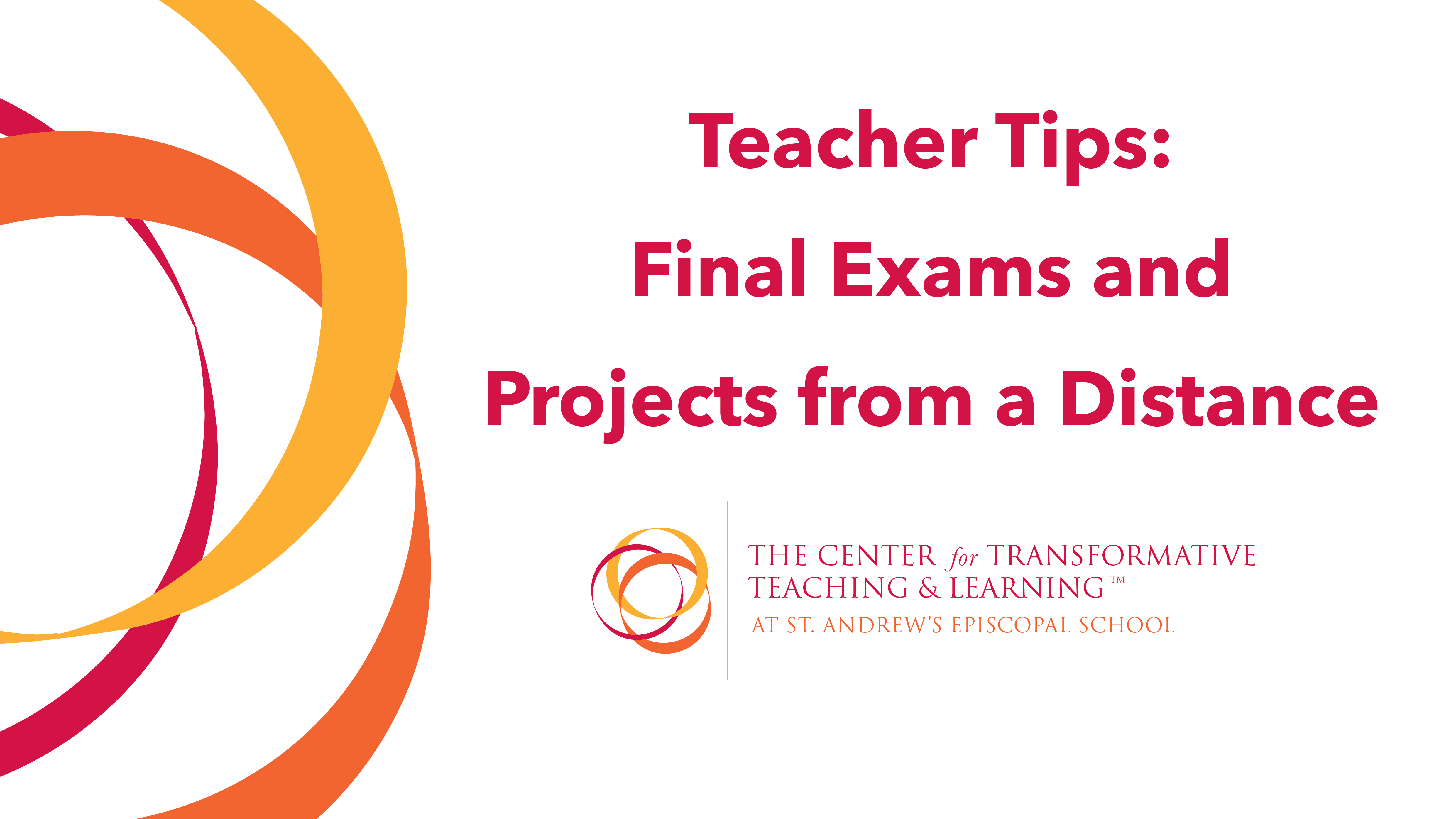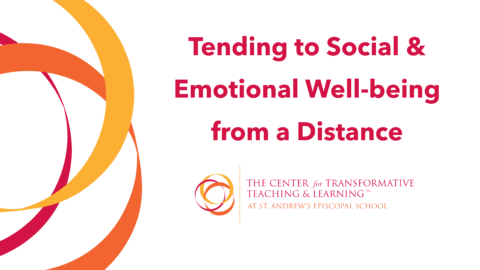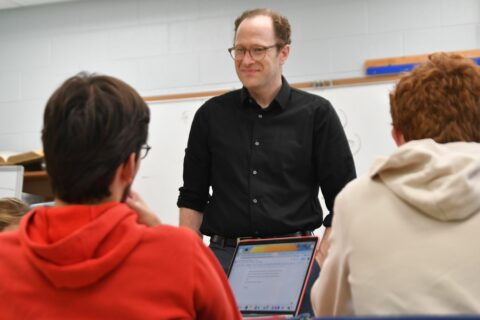By Dr. Ian Kelleher
It’s that time of year again. Suddenly the end of the school year is staring at us like a sun-drenched child at an ice cream truck.

But what does the end look like during this time of what Paul Kirschner, Emeritus Professor of Educational Psychology, Open Universiteit in the Netherlands calls “Emergency Remote Teaching”? How will you summatively assess your students’ ability to meet the learning objectives (adjusted now, I hope) you have set for the year? Whether you are planning some kind of final exam or some kind of project, we have some research-informed strategies to help your students.
PREPARING FOR EXAMS
Research suggests that, left to their own devices, students tend to do a bad job when it comes to choosing effective, efficient study strategies. This year, more than ever, they need you to help them out by teaching effective study strategies during your actual class time and helping them plan their studying. The weirdness of now is impacting stress and executive functioning for many students. They need that bit more structure from us to help them prepare for exams. Even if your class time is scaled back or access is challenging, this should be a priority in the upcoming weeks.
1. Retrieval practice
Retrieval practice should be students’ go-to strategy, not rereading. Students should practice in ways where they generate answers, solutions, or content, and not simply reread their notes or textbook. Students tend to prefer rereading though. But no matter how many highlighters they use, rereading is not as good as retrieval practice. The act of trying to recall information, to generate answers or content, helps long term learning more— even if it feels harder, even if it is a struggle. But because it feels worse, retrieval practice needs to be built into your class time and the assignments you set. Work towards building your students’ independence, however. For example, post model answers and require that students check these and then check their notes before coming to class or coming to you for extra help.
2. Explain it to yourself or someone else
Explaining what you are trying to learn to yourself or to someone else can be done in a variety of ways: words out loud, recording yourself on your phone, drawing, even making a simple video. You can keep what you create to yourself or share. This act of generating understanding can be very helpful in creating lasting memory, and also in identifying places where you do not know the material as well as you thought, and where more studying or seeking a teacher is necessary.
3. Connect knowledge islands to form knowledge webs
Help students connect knowledge together into coherent patterns that make sense to them. Students often see the knowledge and skills in your course as isolated islands, more so than teachers often think. It is part of being a novice learner. But it makes it harder to remember. Thus, helping students make connections can deepen their understanding of your subject, as well as increase their ability to remember it. Activities like creating visual maps, either by hand or using websites like MindMeister, MindMup or bubbl.us, can help. Making students add a connection to another part of your course whenever they create a flashcard is another strategy.
4. Spaced practice
Allowing some forgetting, allowing yourself to get a bit rusty, then trying to retrieve the knowledge or skill again, helps long-term learning. But students tend to be really bad at organizing the spacing themselves. So help them out and give them some structure. They also tend to be bad at self-regulating themselves to stick to the spaced-practice timeline, so find low-stakes ways to build in accountability.
5. What study strategy when?
Give students guidance on what types of strategies might work best for the different parts of your exam. Students are often not as good at figuring this out as you might think.
Want more strategies?
I was reminded last week of the excellent book by Mark McDaniel et al, Make it Stick, and if you want to take a deeper dive into memory strategies, the research behind them, and some stories of what they look like in real classrooms, I highly recommend it.
PREPARING FOR AN AWESOME PROJECT
1. Make sure students are ready
A project is a good way for students to use the knowledge and skills you have taught them in a new context. Make sure you design projects that have this “use in a new context” element to them, rather than having students teach themselves a brand new topic. Doing so is more likely to result in enduring learning. But are students ready for this project? Design simple formative assessments to check, and give those students who need it some extra practice or some targeted reteaching to get them up to speed. Just because you taught it, don’t assume students know it well enough to do a project on it yet.
2. How near or far is the new context of the project?
Students will vary considerably in their ability to transfer the knowledge and skills you have taught them to new contexts. So as you offer choice to students in their projects, be sure to guide that choice — some students will thrive a long way from the original context, others closer to the original work. Also differentiate the constraints and scaffolds individual students receive. The goal is to get the level of stress in the just-right Goldilocks zone for each student. This is especially important with the added stress and reduced day-to-day contact with teachers during these distance learning times.
3. Constraints
The constraints you set are always part of the magic that makes a successful project. They should not be so strict that every project is the same, or so loose that students are left floundering. The constraints you set are often the places that spark students’ creativity. So choose them well. And make sure you make sensible changes to the “normal” constraints that traditional projects have. Again, the goal is to keep each student in the Goldilocks zone of stress, even if this means varying constraints from student to student (since students’ home learning situations will vary so much in so many ways).
4. Instructions
Make sure instructions are astonishingly clear and unambiguous — even more so than for a typical project. Establish clear routines for how students can get in touch with you if they have questions, such as how to email you, how to set up a video chat with you, when “office hours” drop-in times for video chat might be, and what other times you might be available for extra help, plus how to set such a meeting up.
5. Executive functioning scaffolding
The stress, strangeness, and home learning situations of students can mean that executive functioning challenges can be greater than for regular “at school” classes. And some students who didn’t appear to struggle with executive functioning skills may struggle now. Add more supports for critical executive functioning skills, such as help planning the timeline of a project; setting key check-points with clear instructions as to what is due when; giving examples of the type of work students should be heading for; providing a list of suggested strategies and “how to” guides for critical parts of the project; and providing self-check rubrics to help students determine whether they have met the criteria of the project and are ready to hand it in. See this piece by us for more about executing functioning and distance learning.
Ice cream is one of my greatest loves in the world. My favorite all time flavor is Toscanini’s burnt caramel, Central Square, Cambridge, Massachusetts. Some of you may know it. If not, wow, what a treat you have in store. So please, when lockdown is over, if you ever find yourself in Toscanini’s, and you should, take a picture and send it to me: ikelleher@saes.org
Dr. Ian Kelleher is a science teacher at St. Andrew’s Episcopal School, and Head of Research for its Center for Transformative Teaching & Learning. His work focuses on helping teachers translate the science of learning into everyday practices in their own classrooms, and measuring the impact. Ian is the co-author of “Neuroteach: Brain Science and the Future of Education,” and co-designer of Neuroteach Global. Ian is the the inaugural Joseph and Kathleen Dreyfuss Faculty Chair for Research, an endowed position at St. Andrew’s Episcopal School for the lead CTTL researcher.




